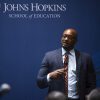When trying to encompass the impact of centuries of systemic inequality, sometimes statistics just aren’t enough.
“I purposely did not use statistics in this presentation,” Richard Lofton, Jr., said in delivering his February 19 talk “Terror in the Schoolyard: Race, Place, and Systemic Inequalities.” “I want you to know and feel and hear the voices of our children and what they are going through.”
Presented during Black History Month, Lofton’s talk took in a broad swath of historical examples to lend perspective to the effects of racial segregation, in multiple forms and across generations, which have left today’s African American students confronting what he characterizes as “systemic terror.” His examples included well-known socioeconomic factors—such as hyper-incarceration, limited access to services, poor housing, and limited employment opportunities—but even more compelling, highlighted the individual voices of student experience.
Lofton, a Johns Hopkins School of Education assistant professor associated with the Center for Social Organization of Schools, is co-principal investigator for the national evaluation of the Student Success Mentor Initiative, which aims to reduce chronic absenteeism, develop caring relationships within schools, and increase successful student outcomes. He is also the associate director of the Johns Hopkins Urban Health Institute.
Four years ago, when he came to Baltimore as a newly minted doctoral grad, he eagerly reached out among the city’s majority African American communities to understand their educational experiences. The results were eye-opening, and sometimes heart-wrenching. Many of the 50 young people he spoke with saw the education system as adults training them to thread their way through “a socially sanctioned gauntlet.”
“I don’t know if I need help navigating something that’s just wrong,” one young man told Lofton. “Why do I want to learn how to move through something that’s wrong?” Another student said, “So, it’s like, just because of the color of my skin, I cannot take advantage of any opportunities, because I don’t know about them.”
For Lofton, these voices, and the broad experience they exemplify, make a stirring case that if we want to nurture and sustain safe and healthy schools, we must also consider the systemic burdens and obstacles faced by African American schoolchildren as a whole.
In addressing those inequities, Lofton advocates creating a broad-based coalition of communities and resources to address these persistent, intergenerational issues. One example he finds inspiring is the Birmingham Promise, a comprehensive initiative by the city of Birmingham, Alabama, to create new career and college opportunities for graduates of its public schools. Announced in May 2019, the initiative offers tuition assistance to cover college costs at any public Alabama higher education institution. It also offers apprenticeships that provide Birmingham high school students with jobs and career experience to prepare them for post-graduation career opportunities.
For Baltimore’s youth, Lofton proposes “The Hawkins Academy,” named after William Ashbie Hawkins, a pioneering African American lawyer from Baltimore. Extending high school for two years, the academy would offer nationally recognized credentials in career and skills training; options for matriculating into state public universities; and support for room, board, and living stipend, among other benefits.
Lofton’s talk was the final lecture in the Center for Safe and Healthy Schools’ inaugural series, which is woven into the coursework for all students in counseling, teaching preparation, special education, and school administration. In total, the five lectures are the core teaching units of the School of Education’s safe and healthy schools curriculum.

